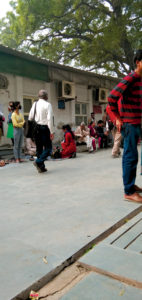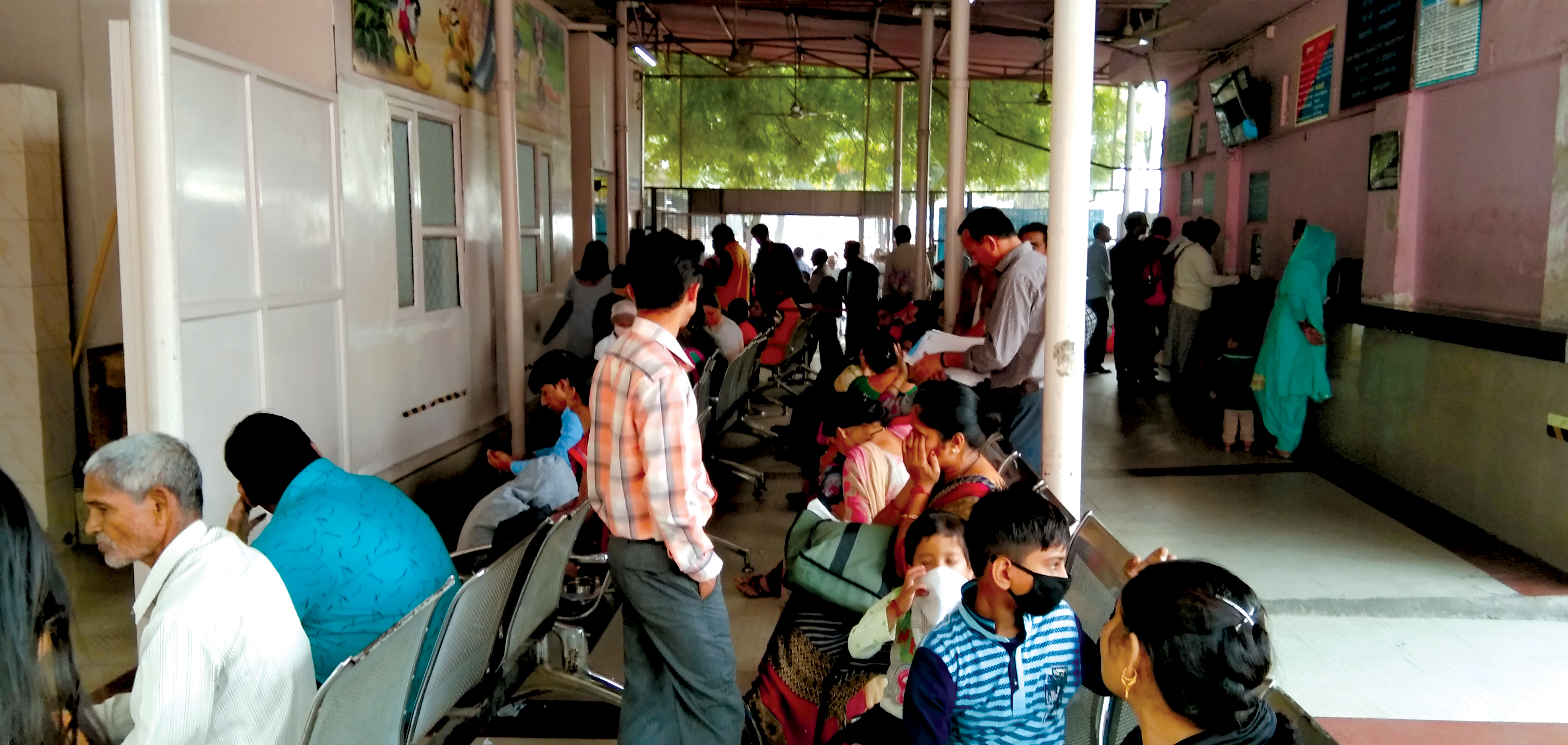At clinics and hospitals across Delhi, there is a jump in patients with lung disease
One of the patients at Nisha Leekha Nursing Home is Bobby Chhikara, a resident of Shahpur Jat in South Delhi, who has just completed his graduation in BA from Bhagat Singh College. He has been an asthma patient for the past 8-9 years. He avoids taking inhalers and had his asthma in control.
But every year, post-Diwali time is a nightmare for Bobby as he is forced to see the doctor. And for the past 10 days, he has been feeling extreme breathlessness and congestion in the chest with a cold. This time, the smog forced him to rush to the nearby clinic. He has to take a five-day course of medicine.
“I started feeling breathless and also started coughing. I was also having cold because of the dip in temperature. I smoke so there was a slight chest pain,” the 21-year-old said.
At clinics and hospitals across Delhi, the health crisis due to the inhalation of hazardous air is very apparent.
On Sunday, Delhi woke to the whole city engulfed in smog. The next morning, All India Institute of Medical Sciences had a long queue of more than 100 people outside the OPD section of the pulmonary department. There was chaos over issuing of appointment slips and maintaining the queue. Most people had come as early as possible to get to meet the doctor at the earliest.
Bir Das, 65 years old, in his crisp white dhoti-kurta, had come all the way from Janakpuri and was standing in a long queue. He had come early in the morning and was happy about getting an early appointment.
He has been feeling breathlessness for a few days now. “Age definitely has a role but it has become more severe due to pollution,” he said.
“The facilities are great in Delhi. I am not paying anything for expensive equipment like inhalers. The travelling fee is less as I have a senior citizen pass. But this pollution is a negative which pulls this city back,” he said.
Bir Das’ age and his breathlessness is no exception as doctors confirm that the people most affected by inhaling this air are older people, kids and pregnant women.

Pradeep Pawar understands this situation better than anyone as he has two people in his family who have asthma. His mother and his son are both asthmatic and Diwali is a difficult time for them. “I got to know that my mother is asthmatic when I was 10 years old. My son Daksh has it from the age of three. As the weather changes, they have some issues. But post Diwali it is mostly due to pollution. Last week, my mom and son both started feeling breathless. My son was given nebuliser,” he said.
Dr Gopi Chand Khilnani, Chairman of Pushpawati Singhania Hospital and Research Institute and former head and professor of pulmonary medicine and sleep disorder in AIIMs, is confident that the number of patients has risen to double of what it used to be. “I don’t have the exact data or research to quantify my claim. Not only the numbers but the severity of the issues has also increased.”
He divides patients into two types— one with pre-existing lung disease like asthma, bronchitis or Chronic Obstructive Pulmonary Disease (COPD). These were well controlled for several years and now have become severe. The other types are the ones with no disease, the healthy young. “One of them is my colleague who is a doctor. Healthy people typically start having soreness of the throat and then they start sneezing. There is general weakness and loss of appetite. However, patients don’t suffer from fever. There is an increase in the prescription of inhalers and antibiotics and there is no response. Ultimately, we put them on steroids. Some of them get admitted and some of them land in ICU also.”
Anitha Mittal, a patient suffering from breathing issues since January this year, falls into the first type described by Dr Khilnani. “Suddenly her condition deteriorated and she was admitted in the ward of pulmonary department in AIIMs,” her relative informed.
A recent study by The Indian Council of Medical Research found that 20-40% of patients in the total 1.25 lakh patients came with respiratory symptoms as the air quality worsened. This was conducted in four centres in Delhi: AIIMS, Vallabhbhai Patel Chest Institute, National Institute of Tuberculosis and Respiratory Diseases and Kalawati Saran Children’s Hospital.
The research was conducted from June 2017 to May 2019. Out of 56,000 children screened in the paediatric emergency room and 70,000 adults in the main emergency room, 20-30% had respiratory symptoms which correlated with the Air Quality Index (AQI).
However, Dr Hemant Kalra, who is a lung specialist with more than 25 years of experience, considers the situation can still be managed. “The air is bad but not as bad as it is being depicted. Healthy people are not succumbing to it in large numbers,” he said.
He points out example of California where a similar smog was handled by efficient managment of vehicles and industries there.
The Maharaja Agrasen Hospital in West Punjabi Bagh in northeast Delhi has around 30 patients on a regular basis. The registration counter said that earlier if it was 20-22, now there are a minimum of 30 patients.
Kalra explains that the alarming depiction of the situation is stopping people from thinking coherently. “Panic prevails. Everyone is buying masks and installing purifiers. The masks are of no use if you are not using a specific mask in the category of n-95 or 97 and that kind of mask only work for 48 hours. The purifiers are only effective if you are in a closed room. These masks are used in the time of epidemics,” he said.
According to doctors, the whole masks industry is unregulated and is trying to profit from the situation. There is a lack of awareness of the kind of mask that needs to be used. “The masks used by the majority is a basic surgical mask or use-throw kind. It is not saving you from pollution,” Kalra added.
He compares it to the panic when dengue was on the rise. “Everyone even with the slightest low count of platelets was getting admitted. Only if your count is below 10,000 is there need to be concerned.”
At Max Super Speciality Hospital in South Delhi, Geetika Methwani underwent a sinus operation last month after facing a complete nose blockage, leaving her unable to breath. This week, she again had to be rushed to hospital because of breathlessness. “The doctor said that the situation has returned because of the polluted air,” Geetika said.
She has been put on steroids and has been asked to reduce her exposure to the outside environment.
Dr Rahul Sharma a pulmonologist in Garg Hospital in Karkarduma situated in the east of Delhi, blames the lack of awareness or demand for quality of life in India. “Quality of life is a luxury in India and most of us don’t even understand the concept. Throughout the year, AQI in Delhi remains at 100-200 and that is bad. Only when it crosses 400 does it get the required attention,” he said.
He has some tips to give. points out one of the crucial aspects of the whole situation. “The lung reserves of a normal healthy person is much more than a person who has certain ailments. But the implications of the air we breathe will be felt later. It is equivalent to smoking at least three cigarettes per day and that it will have its consequence. It will act as a form of slow death,” he said.
Dr Sharma is worried about his daughter. “My wife is a paediatrician and even after having two doctors in the house, we don’t know what to do. We have two purifiers yet the index they show is alarming. The brain development of a child is affected in this air. If you can, please leave this city,” he says.
The month of November to December is considered as the respiratory season by the Doctors. The drop-in temperature and a change in overall weather anyway witness an increase in the number of patients.
At Ram Manohar Lohia Hospital Dr Rajneesh Kaushik of the pulmonology department explains the difficulty in quantifying the correlation of toxic air to deteriorating health. “There is a 10-12% increase in patients. But toxic air can only be one of the reasons. The PM2.5 and PM10 particles are small and may not enter from your nose, they can enter your eyes can affect your heart and also can get absorbed by the blood,” he says.
The politics behind the whole situation is also irking the doctors. “I recently had patients from Haryana and Punjab and I asked them why do you opt for stubble burning? What they said was also right. They don’t have the money to invest in expensive machines and this is the easiest option. They themselves are suffering. The whole political banter without a solution is problematic. They (the governments) should sit together and find out a permanent solution,” he said.
www.newslaundry.com





